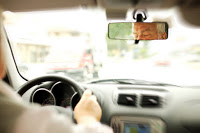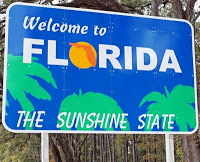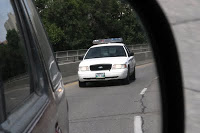
Remember the Time Change Can Affect Your Driving
November 2, 2011
It’s that time of the year again; time to fall back and set the clocks to Standard Time. The time change can cause disruptions while our mind and body adapt to the new time and that disruption can extend to our driving.
Changing back from Daylight Savings Time to Standard Time occurs on the first Sunday in November and that falls on November 6th this year. The time change officially happens at 2:00 AM on Sunday November 6th. Falling back means setting the clock back one hour; at 2:00 AM set your clocks back to 1:00 AM. The great thing about falling back is that we all get an extra hour of sleep on Saturday night. Those who don’t get the word will probably arrive at church an hour early and wonder where everyone is or why that football game hasn’t started yet.
The time change is always somewhat confusing because it takes our minds a few days to adapt to the new change. Those of you who are used to waking up and beginning your morning commute in the dark will be waking up to the sunrise. Those who enjoy the extra sunlight after work will be getting home in the dark.
The time change in the fall isn’t as disruptive as the spring time change. In spring we lose an hour of sleep and sleep experts say that losing even one hour of sleep can have an impact on our driving and driving while drowsy is just as dangerous as driving under the influence. However, even though we aren’t going to lose any sleep, our driving can still be affected because of the time it takes our internal clock to adjust to the change.
Our internal biological clock or circadian rhythm regulates our wake sleep cycle. It was easy before clocks were invented; we woke up at dawn and we went to sleep when it got dark. Sleep experts also say it is natural for us to become sleepy in the late afternoon. In the modern world, our days are regulated by the clock and that mechanical clock can sometimes come into conflict with our biological clock. Some sleep experts suggest that we follow the example of Mediterranean cultures and allow employees to nap in the afternoon in order to gain maximum performance. When we force ourselves to remain awake through that natural afternoon drowsy time, it can lead to drowsiness behind the wheel on the long commute home. One survey of drivers found that more than one-third (35%) of drivers who nodded off while driving within the previous six months say their last experience occurred between 6:00 a.m. and 5:00 p.m. An additional 17% report they nodded off between 5:00 p.m. and 9:00 p.m.
A study using mice (that also has implications for humans) found that when circadian rhythm cycles were disrupted, the mice didn’t perform as well in maze tests as the control group whose circadian patterns weren’t disrupted. They also exhibited impulsive behavior which, for human drivers, can mean trying to beat that light or pulling out in front of another car. When darkness suddenly falls an hour earlier, drivers may find themselves driving a little faster; trying to get home before daylight fades.
Another problem occurs because light conditions at dusk – before total darkness – can be confusing. Shapes that show up clearly in daylight or in a car’s headlights may not show up as clearly at dusk. A study conducted in 1995 found that the number of auto/pedestrian crashes increased substantially in the period following the time change back to standard time. Kids are still walking home from practice or trying to get in a little extra playing time with their neighborhood pals before total darkness. A University of California trauma center found a “62 percent increase in the number of children in auto-vs-pedestrian crashes and auto-vs.-bicycle crashes in the two weeks following the October time change. Of these victims, 90 percent had severe injuries and required surgery.”
Until their body clock adjusts to the new time, drivers should be especially cautious during the first few weeks after the time change. Get plenty of sleep, don’t give in to the impulse to rush home to beat the sunset, and be especially watchful for pedestrians.
Drowsy driving prevention week is Nov.6 – 12. For more information on sleep and sleep disorders, visit the National Sleep Foundation’s web site at: http://www.sleepfoundation.org/

Teen Passengers of Teen Drivers
October 18, 2011
As teen passengers in a car with a teen driver, would you or could you ask the driver to:
- stop texting,
- stop talking on a cell phone,
- buckle up,
- not drink and drive,
- slow down, or;
- pay more attention to the road ahead?
All of these activities are dangerous yet teen passengers of a teen driver seem to be reluctant to ask the driver to drive more safely and they pay dearly as a result.
Car crashes are the leading cause of death for teens and more than half of the teens killed in car crashes each year are passengers of another teen driver. A study by The Children’s Hospital of Philadelphia found that 60 percent of teens think inexperience heavily influences safety, but only 15 percent consider their peers to be inexperienced. Apparently, teens equate experience with the ability to pass the driving test and earn a license rather than time on the road and exposure to a variety of driving situations.
A recent study by the AAA Foundation for Traffic Safety, showed that teen drivers are about 50 percent more likely to crash in the first month of unsupervised driving than they are after a full year of experience driving on their own, and they are nearly twice as likely to crash in their first month as they are after two full years of experience.
Distracted driving is one of the leading causes for crashes among all age groups but it is especially high among teen drivers. Teen passengers add to the distractions and the risk of a crash increases with each additional teen passenger yet only 10 percent of teens realize that carrying teen passengers increases the risk of a crash.
Another factor leading to teen passenger deaths is that teens have the lowest rate of seat belt use and they are less likely to wear a seat belt when they are a passenger of another teen than when they are driving alone.
The website www.teendriversource.org, has produced an informational brochure called “Teach Your Teen To Be A Smart Passenger”. Parents continue to be the strongest influence in a teen’s life and, by setting strong rules for teens, both as a driver and a passenger, they can help prevent some of the dangerous situations that teens are prone to get into.
Prepping for a Homecoming: Communication
September 26, 2011
Here are some tips on exactly what to discuss when prepping for homecoming:
Communicate with other parents; then, talk to your teen about their friends’ parents. Being part of a social group does not guarantee that other parents share the idea of a zero-tolerance policy for alcohol. Some parents even choose to “look the other way” when hosting teen get-togethers, reasoning that at least, the teens are in a “safe” environment. This is illegal in any state. Communicate with these other parents to find out if they know where their teens will be after homecoming night. Even better, if the teens plan to spend time in another teen’s home, find out if the parents are willing to chaperone. Communicate the importance of accounting and locking up alcohol in their homes. When communicating with your teen, make sure that they know that it’s always alright to say “no.” Ask if they will be riding with teens whose parents also have a zero-tolerance policy for alcohol.
Come up with a safety code. This could be something a teen may text their parent if they are in an uncomfortable situation, and they need an exit. Something like a code to signal, “Get me out of here!” On your end, make sure that your teen knows that you will be discrete upon receiving this code. This could also be something that a teen can do to “check in” with their parents. Maybe texting something like, “dinner was awesome!” could mean that the teen has arrived at an after-homecoming destination safely.
Discuss the teen’s planned itinerary for the evening, and require the teen to inform you of any changes. Make teens feel they could trust you not to bug them on homecoming night, if they promise to keep their end of the bargain by checking in and informing you of any changes in the plan.
Doing so will hopefully make homecoming night a “night to remember,” instead of being “the night when my mom bugged me all night, until I got home.” Pre-plan, communicate and have fun!

The Best And Worst Cities For Driving In Florida
September 13, 2011
Allstate Insurance Company released their annual report on the best and worst cities in which to drive. The study looked at Allstate collision claims and compared them to the national average and ranked the nation’s cities by population. To prevent any type of special event such as floods and hurricanes from skewing the results, the Allstate actuaries analyzed figures over a two year period to reach their results.
The list shows a driver’s likelihood to be involved in a collision and the average number of years a driver in that city can expect to go between collisions. Based on their results:
The top five safest cities in Florida for drivers, in terms of ranking, are:
1. Port Saint Lucie – A driver in Port Saint Lucie can expect to go 11.2 years between collisions and the chances for being involved in a collision are 10.4 percent less than the national average. Port Saint Lucie was ranked number 24 overall in the national list of safest cities in America.
2. Cape Coral – A driver in Cape Coral can expect to go 10.5 years between collisions and the chances for being involved in a collision are 4.8 percent less than the national average. Cape Coral was ranked number 42 overall in the national list of safest cities in America.
3. Tallahassee – A driver in Tallahassee can expect to go 9.8 years between collisions and the chances for being involved in a collision are 1.9 percent more than the national average. Tallahassee was ranked number 66 overall in the national list of safest cities in America.
4. Jacksonville – A driver in Jacksonville can expect to go 9.7 years between collisions and the chances for being involved in a collision are 3.1 percent more than the national average. Jacksonville was ranked number 73 overall in the national list of safest cities in America.
5. St. Petersburg – A driver in St. Petersburg can expect to go 9.7 years between collisions and the chances for being involved in a collision are 3.3 percent more than the national average. St. Petersburg was ranked number 74 overall in the national list of safest cities in America.
The top five most dangerous cities in Florida for drivers, in terms of ranking, are:
1. Hialeah – A driver in Hialeah can expect only 6.6 years between collisions and the chances for being involved in a collision are 52.5 percent more than the national average. Hialeah was ranked number 183 overall in the national list of safest cities in America.
2. Miami – A driver in Miami can expect only 7.0 years between collisions and the chances for being involved in a collision are 43.1 percent more than the national average. Miami was ranked number 178 overall in the national list of safest cities in America.
3. Tampa – A driver in Tampa can expect only 7.1 years between collisions and the chances for being involved in a collision are 41.7 percent more than the national average. Tampa was ranked number 176 overall in the national list of safest cities in America.
4. Hollywood – A driver in Hollywood can expect only 7.8 years between collisions and the chances for being involved in a collision are 28.2 percent more than the national average. Hollywood was ranked number 154 overall in the national list of safest cities in America.
5. Orlando – A driver in Orlando can expect only 8.0 years between collisions and the chances for being involved in a collision are 25.5 percent more than the national average. Orlando was ranked number 149 overall in the national list of safest cities in America.
The complete Allstate report can be seen at: http://allstatenewsroom.com/releases/00c90674-c797-4dd0-82c8-3813ccbe1e1e:en-US/download/e3fc06ab-a016-4248-89ef-72454729bd0a

How to Get a Florida License Reinstated on a Hardship License
August 8, 2011
Having your license revoked or suspended can cause different things to different people. Some people may end up losing their job if they are not able to get there. Some students may end up failing classes or even needed to drop out of school. Whatever it was that caused you to lose your driving privileges, there might be hope. Depending on the circumstance of the suspension, some drivers may be given the opportunity to pursue a hardship license.
A Florida hardship license is a special license that allows drivers to get to drive only to very specific places, while they work on getting their full license back. In short, it allows people to drive to and from work/home/school, while they work on their full license.
In some cases, it is mandatory (for Habitual Traffic Offenders) for a driver to take up advanced driver training BEFORE they are able to apply for a hardship license. This is the way to get a license reinstated.
These are the steps required in getting a Florida license reinstated:
Request for your driving record – In some instances, you may order this online, or you may get it from your local clerk of court.
Contact your local Administrative Reviews office – You have to submit your driving record and your course enrollment letter to your local Administrative Reviews office. They are the government agency that will grant you your hardship license if you are eligible.
Complete Advanced Driver Improvement Course – If you are eligible, you may be able to obtain your hardship license from the hearing officer. With this hardship license, you are now able to drive to your school or place of work. You have to complete advanced driver training to get your driver’s license reinstated. If you are classified as a Habitual Traffic Offender, you will be required to take the course before even applying for a hardship license.
Not being able to get anywhere can become the ultimate form of inconvenience our time and freedom. Do not waste it. Become a better driver, keep yourself and others safe when driving.
